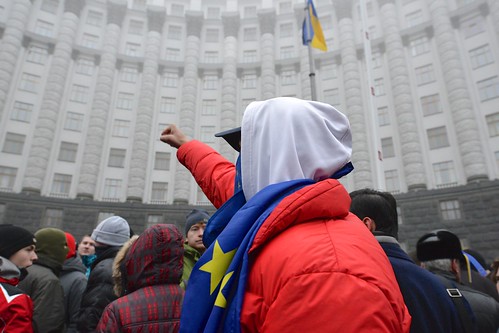Ukraine: Provoking the Euromaidan
By Sean L Hanley, on 3 December 2013

Photo Ivan Bandura CC-BY 2.0
Far-right activists have been infiltrating the protests in Ukraine and provoking police and demonstrators to violence reports Anton Shekhovtsov.
The U-turn on the Association Agreement with the EU by the Ukrainian government has sparked the most massive social protests since the ‘Orange Revolution’ in 2004. Unlike the ‘Orange revolution,’ however, the new protests, named ‘the Euromaidan,’ have been marked by the government’s disproportionate use of violence against the non-violent protests. The authorities have been making use of paid instigators who infiltrate the protests and then start attacking the police to provoke a ‘retaliatory’ suppression of ‘violent protestors.’
1 December was a day of blood and violence. The Ukrainian opposition had planned a peaceful protest against the brutal beating of several hundreds of protestors, the day before, by 1,000-2,000 members of the ‘Berkut’ special police unit. However, the gathering of hundreds of thousands of people was overshadowed by the clashes on Bankova Street leading to the building of the Presidential Administration, where the Berkut held the line against an extremely violent 200- strong crowd.
Media reports at first referred to this hardcore group – many of them masked – as ‘unknown activists;’ unknown because nobody knew if their actions were, in fact, sanctioned by the opposition. Since the opposition had specifically renounced any use of violence, the media soon started to refer to these men as ‘provocateurs.’ They threw flares, smoke bombs, Molotov cocktails and stones at the police, beat them with chains, fired tear gas, and brought up an excavator to break through the police cordon.
The police did not respond, stood their ground and used megaphones, urging the troublemakers to stop. Some other protesters, later joined by businessman and politician Petro Poroshenko, understanding the deliberately provocative nature of what was happening, tried to calm things down, which only resulted in fights between protesters. Eventually, the violent crowd again started attacking the police. This time, the police were replaced by the Berkut troops, which dispersed the crowd severely beating dozens of people including 40 Ukrainian and foreign journalists. Guilty or not guilty, everybody in the wrong place in the wrong time was beaten up. The opposition’s leaders, Vitali Klitschko (UDAR) and Oleh Tyahnybok (far right Svoboda) themselves went to Bankova Street to urge the troublemakers to join the peaceful protests on Maidan (Independence Square).
Who were these troublemakers? (more…)
 Close
Close


